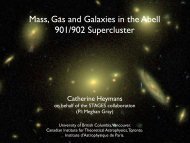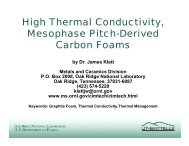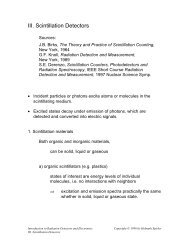Introduction to radiation-resistant semiconductor devices and circuits
Introduction to radiation-resistant semiconductor devices and circuits
Introduction to radiation-resistant semiconductor devices and circuits
Create successful ePaper yourself
Turn your PDF publications into a flip-book with our unique Google optimized e-Paper software.
Effective Doping Concentration [cm -3 ]<br />
10 14<br />
10 13<br />
10 12<br />
10 11<br />
10 10<br />
10 9<br />
10 8<br />
10 11<br />
N d0 = 10 13 cm -3<br />
N d0 = 10 12 cm -3<br />
10 12<br />
above equations must be modified accordingly. Moderate resistivity n type material<br />
(ρ = 1 <strong>to</strong> 5 kΩcm) used in large area tracking detec<strong>to</strong>rs is usually dominated by<br />
donors.<br />
Annealing of ionized accep<strong>to</strong>r states<br />
After defect states are formed by ir<strong>radiation</strong>, their electronic activity changes<br />
with time. A multitude of processes contribute, some leading <strong>to</strong> beneficial<br />
annealing, i.e. a reduction in accep<strong>to</strong>r-like states, <strong>and</strong> some increasing the accep<strong>to</strong>r<br />
concentration. The third term in Eq. 4 describes the beneficial annealing (17),<br />
where gs= 1.93⋅10 -2 cm -1 <strong>and</strong> τ (T)= (6⋅10 6 )⋅exp[-0.175(T-273.2)] s (<strong>to</strong> set the<br />
scale, τ(0°C)= 70 d). The fourth term in Eq. 4<br />
⎡<br />
NY ( Φ , t1/2 , T ) = gYΦ<br />
⋅⎢1− ⎣<br />
10 13<br />
Fluence [cm -2 ]<br />
10 14<br />
FIGURE 3. Calculated effective doping concentration vs. high-energy pro<strong>to</strong>n<br />
fluence for silicon with initial donor concentrations N d0 of 10 12 <strong>and</strong> 10 13 cm -3 .<br />
1 ⎤<br />
1+<br />
gYΦ ⋅ k( T ) ⋅<br />
⎥<br />
t ⎦<br />
10 15<br />
where for 1 MeV neutrons gY= (4.6±0.3)⋅10 -2 cm -1 <strong>and</strong> for 1 GeV pro<strong>to</strong>ns values<br />
of gY= (4.97±0.23)⋅10 -2 cm -1 (16) <strong>and</strong> (5.8±0.3)⋅10 -2 cm -1 (9) have been found. The<br />
temperature dependent evolution is determined by<br />
10<br />
(5)<br />
−<br />
k T k e<br />
Ea / kBT ( ) = 0 (6)





